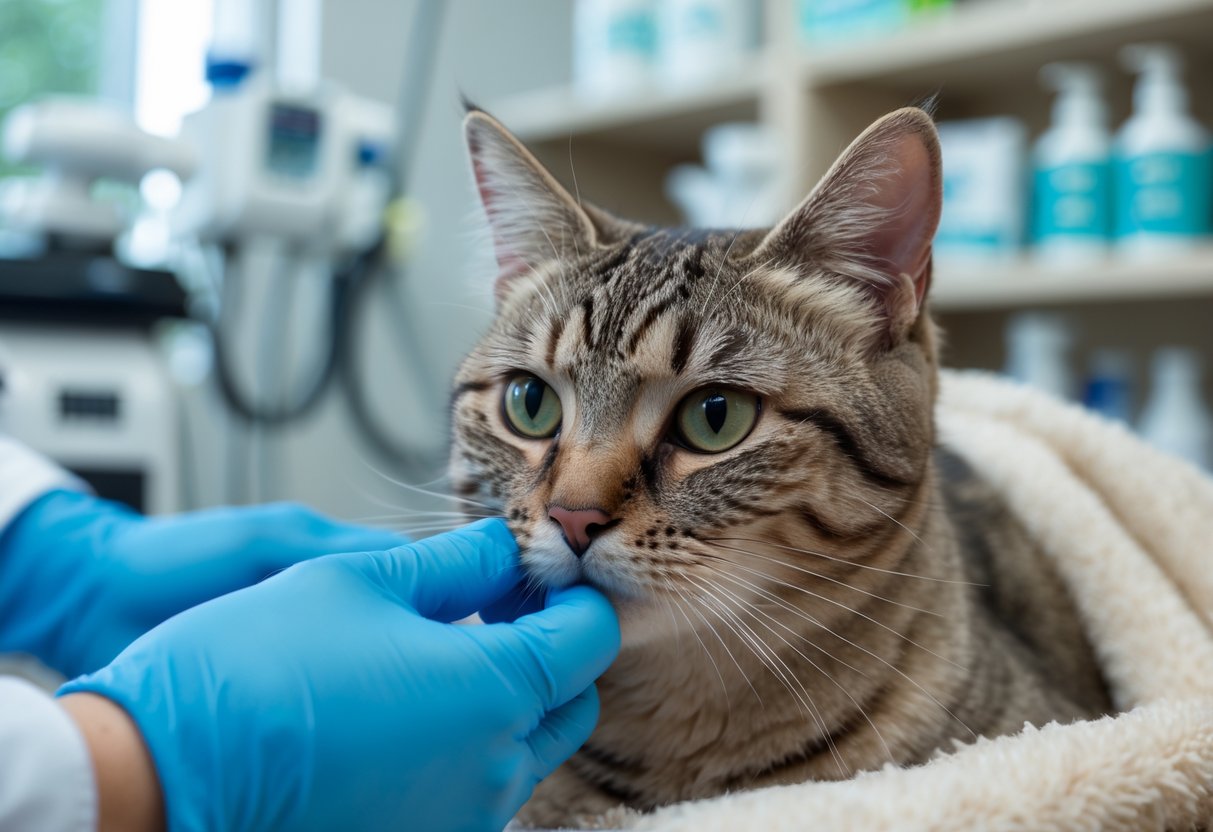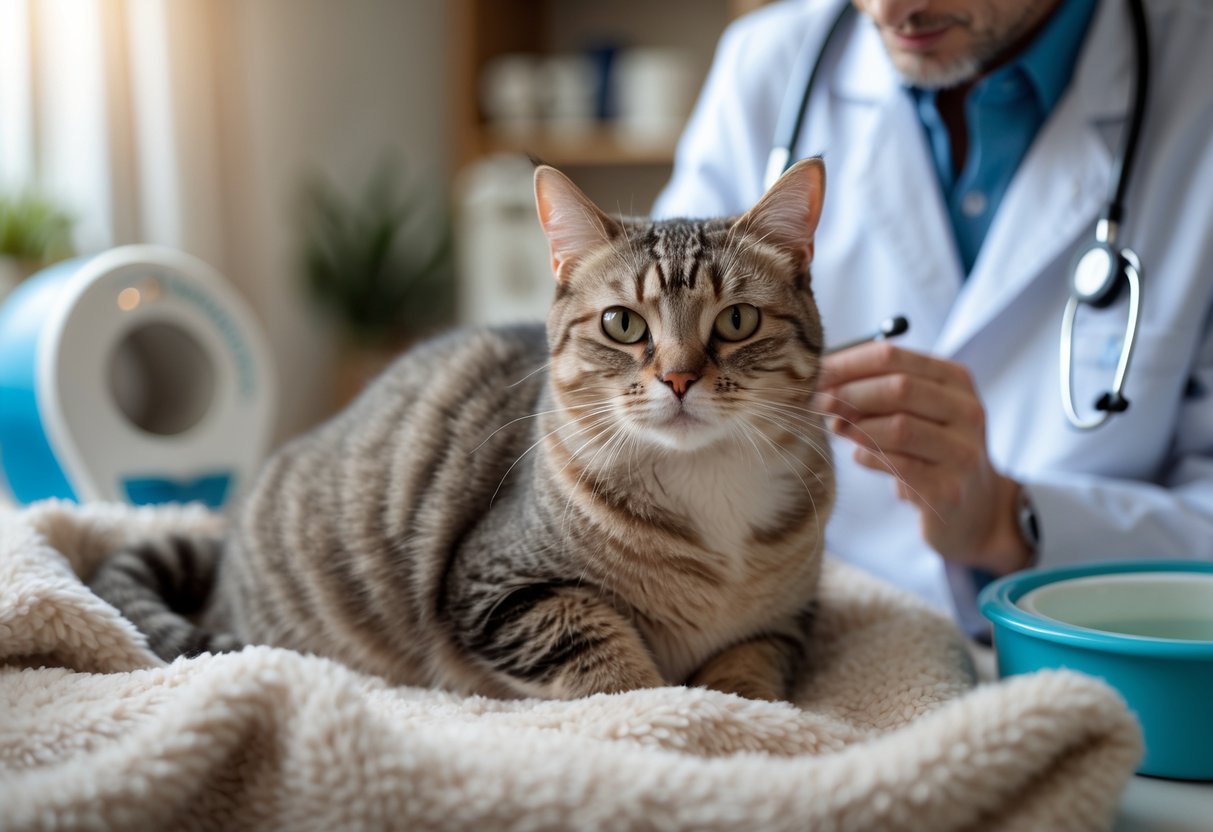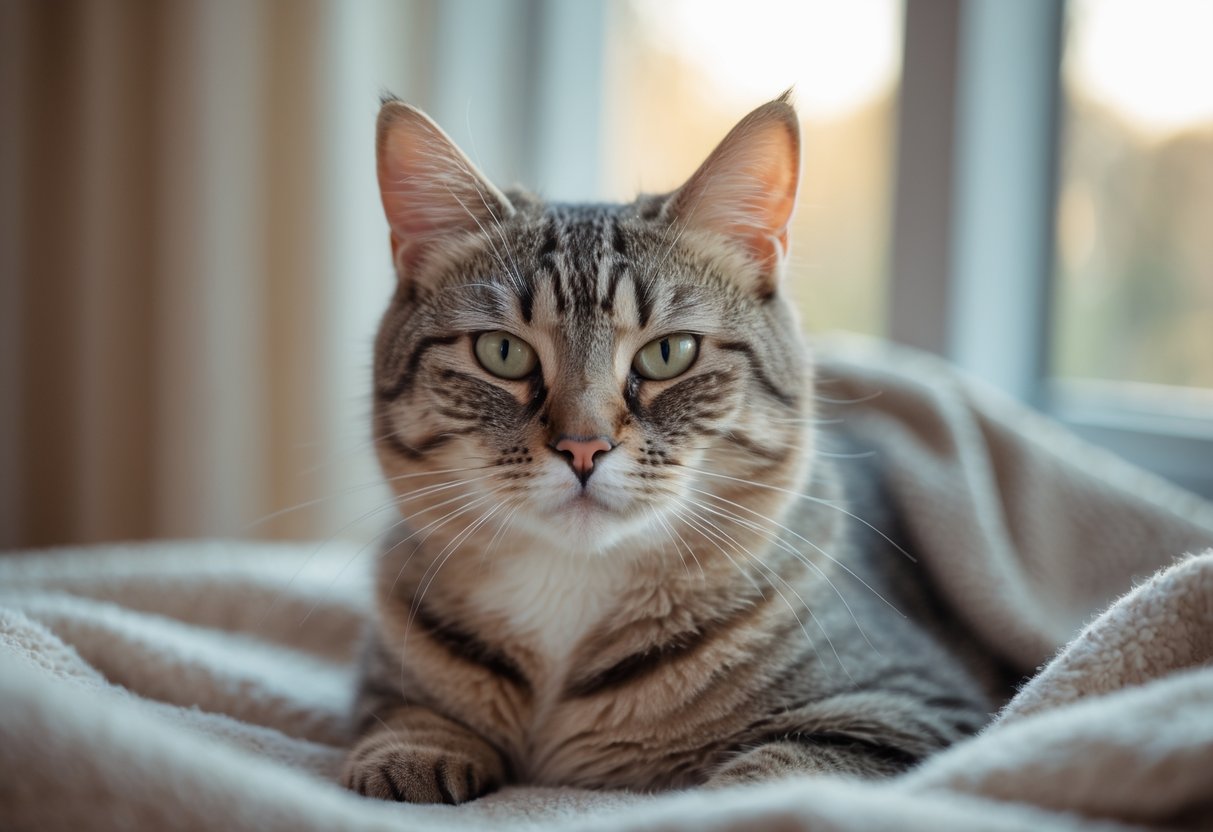Physical Address
304 North Cardinal St.
Dorchester Center, MA 02124
Physical Address
304 North Cardinal St.
Dorchester Center, MA 02124

Cats can get colds too, and one of the most common issues they face is an upper respiratory infection (URI). An upper respiratory infection in cats usually causes sneezing, runny noses, and watery eyes, and can be mild or sometimes more serious if not treated properly. Knowing what to watch for helps owners keep their cats safe and comfortable, especially since some cats are more at risk than others.

Upper respiratory infections can be caused by viruses or bacteria that spread easily between cats, especially in places like shelters or multi-cat homes. The symptoms often look a lot like a human cold, but cats can get very sick if they are young, very old, or have health problems. By learning the signs and how these infections spread, cat owners can respond sooner and help stop it from affecting other cats at home.

Cat upper respiratory infections can cause sneezing, runny noses, and other uncomfortable symptoms. These infections are common, can be acute or chronic, and spread easily among cats, especially in crowded environments.
A feline upper respiratory infection (URI) is an illness that affects a cat’s nose, throat, and sinuses. It is often called “cat flu”. The most common causes are viruses like feline herpesvirus type-1 (FHV-1) and feline calicivirus (FCV), but certain bacteria such as Bordetella bronchiseptica and Chlamydophila felis can also play a role.
Symptoms may include:
A cat with a URI is usually not at risk to people, but the infection can be highly contagious to other cats. Direct contact or sharing food bowls, toys, or litterboxes can spread the disease.
Acute cat URIs appear suddenly and typically last 7 to 10 days. During this time, symptoms are most noticeable, but with proper care, most cats recover well. Some may need medications like antibiotics for secondary infections.
Chronic feline upper respiratory infection means a cat has ongoing or repeat symptoms that may last weeks or months. Chronic URIs happen if the infection never fully clears or because of an ongoing carrier state. Cats who had an acute infection may still carry the virus and have flare-ups, especially under stress. Chronic URI can lead to more severe health problems and often requires long-term management. Some cats may unknowingly spread the infection even after their main symptoms disappear.
Upper respiratory infection in cats affects cats of all ages and breeds. However, it is much more common in kittens, shelter cats, and those living in close contact with other cats, like catteries or boarding facilities, due to the contagious nature of URI-causing organisms.
Certain breeds, such as Persian cats, are at higher risk because of their facial shape. Vaccines help lower the risk and severity, but vaccinated cats can still have mild infections. Studies suggest that about 90% of all feline URIs are caused by herpesvirus or calicivirus. Preventing the spread through good hygiene and separating sick cats is very important in multi-cat homes and shelters.

Upper respiratory infections (URIs) in cats develop for many reasons, and several things can make cats more likely to get sick. Both viruses and bacteria can play a role, along with a cat’s environment and its contact with other animals.
Viruses are the most common cause of upper respiratory infections in cats. Feline herpesvirus-1 (FHV-1) is a major culprit. Once a cat gets FHV-1, it can carry the virus for life and show symptoms when stressed. Feline calicivirus (FCV) is another main virus, known for causing sneezing, runny nose, and sometimes mouth ulcers.
Both FHV-1 and FCV spread easily in areas where many cats live together, such as shelters. Vaccines help lower the risk but do not fully prevent infection. Cats of all ages can be infected, but kittens and older cats are at the highest risk. Viral infections often weaken the immune system, allowing for other problems to develop. Learn more about these common viruses at petshun.com.
While viruses start most feline URIs, bacteria can make the illness worse by infecting weakened tissues. Common bacteria include Bordetella bronchiseptica, Chlamydophila felis, and Mycoplasma species. Chlamydophila felis mostly causes eye problems like conjunctivitis, while Bordetella bronchiseptica leads to coughing and more severe symptoms.
Secondary bacterial infections are frequent in cats with viral URIs. These infections usually follow a viral attack, as the body’s defenses are already down. When bacteria are involved, symptoms can be more serious, and antibiotics may be needed. Early treatment of secondary bacterial infections can help prevent complications. More details can be found at vetverified.com.
Living arrangements and stress play a big role in whether a cat catches a URI. Cats in crowded places like shelters, catteries, or multi-cat homes have a greater risk. Shared spaces mean viruses and bacteria travel quickly from one animal to another.
Poor air quality, dirty living areas, and lack of ventilation increase the chance of infection. Stress from moving, new pets, or changes at home can lower a cat’s immune defenses. Unvaccinated cats and kittens are much more vulnerable. Good hygiene, regular cleaning, and proper vaccination are crucial to keeping cats healthy. For more information, see vetverified.com.
Some cats become carrier cats after recovering from an infection. They do not look sick but can still spread diseases like FHV-1 or Chlamydophila felis, especially during times of stress or illness. Carrier cats can quietly infect others through close contact, sneezing, grooming, or sharing food and water bowls.
Transmission can even happen from litter boxes or bedding. Keeping sick cats separate from healthy ones helps contain the infection. If adopting a new cat, it should be kept apart for two weeks before meeting other pets in the home. Carriers make controlling disease in group settings more difficult, but understanding their role is key to stopping the spread. Visit vetverified.com to understand more about carrier cats and how diseases move between cats.

Upper respiratory infections in cats often cause noticeable signs that affect the nose, eyes, and sometimes the mouth and throat. Spotting these symptoms early can help keep a cat comfortable and prevent further complications.
One of the first signs people notice is frequent sneezing. Sneezing happens as the infection irritates the lining of the nose and airways. With this, many cats also develop nasal discharge. The fluid that comes out of the nose can start clear and watery but may turn thick or colored, such as yellow or green, if a bacterial infection is present.
This discharge may block the cat’s nostrils, making it harder for them to smell or breathe through their nose. Cats that cannot smell well often lose their appetite and may seem less interested in food. Wiping away the nasal discharge with a soft, wet tissue can help them feel better.
Cats with upper respiratory infections often develop eye discharge. The eyes may water a lot at first, but discharge can turn cloudy or pus-like as the infection continues. Some cats develop conjunctivitis, which means the pink tissue around the eyes becomes swollen and red.
Common signs to look for include the cat squinting, blinking more than usual, or rubbing at their face. Some will have their eyes partly closed most of the time. Both bacterial and viral infections can cause these problems. Wiping the eyes with a moist cotton ball can help prevent crusting and reduce irritation. Learn more about these symptoms from WebMD’s overview of cat upper respiratory infection symptoms and treatments.
Coughing is less common than sneezing, but it can happen if the infection irritates the throat or windpipe. Some cats may cough up mucus or make hacking sounds. Coughing can be a sign that the illness is affecting the lower airways as well.
Certain viruses, such as calicivirus, can cause ulcers in the mouth. These sores are often found on the tongue, gums, or roof of the mouth. Ulcers can make eating painful. Affected cats may drool, refuse food, or paw at their mouths. If a cat shows any of these signs, a visit to the vet is important to prevent dehydration and ensure they get proper care. For more information on coughing and oral changes, visit VCA Animal Hospitals’ page on feline upper respiratory infection.
Some cats have a higher chance of getting upper respiratory infections because of their age, health, or living situation. Knowing which cats are more at risk can help keep them healthy and safe.
Kittens are especially vulnerable because their immune systems are still developing. They often get exposed to viruses and bacteria when they leave their mother or first meet other cats.
Unvaccinated kittens face the highest risk, as they have little protection against common illness. Kittens in shelters or rescues where many cats mix together are even more likely to get sick.
Symptoms in kittens can include sneezing, runny nose, and watery eyes. If not treated quickly, they can lose weight and become dehydrated. Early vaccination and keeping kittens separate from sick cats can help lower their risk of infection. To learn more about how kittens are affected, visit this detailed guide on cat flu and upper respiratory infection.
Older cats have weaker immune systems, making it harder for them to fight off infections. Cats with diseases like feline leukemia virus (FeLV) or those that are taking medicines to suppress the immune system are also more at risk.
Elderly or immunocompromised cats can get much sicker if they catch an infection. Some may develop chronic signs, such as ongoing eye or nose discharge, or take longer to recover. FeLV-positive cats, for example, are more likely to get severe symptoms.
Extra care is needed for these cats. Owners should keep them indoors, make vet appointments at the first signs of illness, and avoid exposing them to new or sick cats. More details can be found at feline respiratory disease complex.
Environments with many cats, like shelters, catteries, or feral colonies, have a high risk of spreading upper respiratory infections. Viruses and bacteria can travel through sneezes, shared food bowls, and even caretakers’ hands.
Stress plays a big role, too. Moving, introducing new pets, or changes at home can weaken a cat’s immune system and make infection more likely. Cats under stress tend to get sick more often or can flare up with old infections.
To reduce illness, groups of cats should be kept small when possible. Cleaning, using separate food and water bowls, and isolating sick cats help limit the spread of disease. You can read more about these environments at Cornell University Feline Health Center.
Feline upper respiratory infection is diagnosed by looking at a cat’s symptoms and medical background, together with certain tests. Accurate diagnosis helps veterinarians choose the right treatment and prevent spreading the infection.
A vet will first ask about the cat’s recent health, vaccinations, and if it has been around other cats. It is important to mention any new stress, travel, or changes in its environment.
The exam starts with checking for signs like sneezing, nasal discharge, coughing, eye discharge, fever, and loss of appetite. These are common in infections caused by viruses or bacteria.
The vet may also listen to the cat’s breathing and check its eyes, nose, and throat for redness or swelling. Observing these signs helps narrow down the cause.
If the cat lives with other animals, or in places like shelters, this detail is key since these infections are more common in groups. This step helps the vet tell if the infection is likely from viruses such as herpesvirus or calicivirus, or from bacteria like Bordetella or Chlamydia (see here for more).
Sometimes, signs alone are not enough, especially if the cat is very sick or not improving. The vet may then suggest tests to find out which germs are causing the infection.
Common tests include swabs from the nose, throat, or eyes. These are sent to a lab for PCR testing, which looks for viral or bacterial DNA to confirm the cause.
Blood work may be done to check the cat’s overall health and look for other problems. In rare cases, X-rays help rule out lung disease or other issues if the infection is severe.
Testing is especially helpful in shelters, catteries, or when many cats appear sick at once (learn more). These steps make sure the cat gets the right care and others are kept safe.
Most cats with upper respiratory infections will get better with proper care at home and, at times, medications from the vet. Some severe cases may need more advanced treatments or even a hospital stay.
Home care is very important for cats with respiratory infections. Keeping the cat warm, comfortable, and in a calm, quiet area helps them rest and reduce stress.
Gently clean away eye or nose discharge using a damp cotton ball or soft cloth. This should be done several times each day to keep sensitive areas clear. Running a humidifier or letting the cat sit in a steamy bathroom for about 10-15 minutes is helpful for congestion.
Hydration is key. Make sure fresh water is always available. Many cats eat less when sick, so offer strong-smelling foods like tuna, chicken, or warmed-up wet cat food. Some may need to be tempted with small, frequent meals. If a cat refuses to eat for more than 24 hours, a vet should be contacted quickly.
For more advice on home care and tips to make your cat comfortable, check out this feline upper respiratory infection guide.
Mild upper respiratory infections often improve without prescription drugs, but some cases require medication. Antibiotics like amoxicillin or doxycycline can help if there is a bacterial infection or suspected secondary infection.
Antiviral medications may be prescribed for cats with severe viral infections, especially those caused by the herpesvirus. One common antiviral that may be used is famciclovir. This medication is sometimes chosen for cats with persistent or severe symptoms.
Eye drops or ointments may help if there is conjunctivitis (eye inflammation). Appetite stimulants can be prescribed if a cat is refusing food. All medications should be given exactly as directed by the veterinarian and the entire course must be completed, even if the cat seems better.
Read more about medical treatments and medications for feline respiratory infections at this detailed article.
If a cat becomes very sick, such as having trouble breathing, not eating or drinking, or becoming extremely weak, hospitalization may be needed. At the animal hospital, the vet team can give intravenous fluids to treat dehydration and sometimes use a feeding tube to make sure the cat gets enough nutrients.
Oxygen therapy may help cats with severe breathing trouble. Stronger medications and round-the-clock monitoring are provided in the hospital until the cat is stable and can safely return home.
Special care is especially important for kittens, senior cats, or those with weak immune systems, as URIs can progress quickly in these groups. For more information about when hospitalization is needed and what to expect, visit this complete treatment overview.
Chronic upper respiratory infections in cats often come back or never fully go away. Special care and prevention can help improve a cat’s comfort and lower the chances of new flare-ups.
Cats with chronic URI, especially those with feline herpesvirus, can become lifelong carriers. These carrier cats may not seem sick all the time, but stress, illness, or changes in the home can cause the infection to flare up again.
To help carrier cats, daily routines should be calm and consistent. Reducing stress—like avoiding loud noises or frequent visitors—can keep symptoms under control. Using pheromone diffusers or giving each cat its own space can help lower anxiety.
Clean the cat’s living area often and make sure it always has clean water and fresh food. For ongoing nasal or eye discharge, use a damp cloth to gently clean the face.
Medications such as antivirals (like famciclovir) may be used for cats who keep showing signs of infection or have severe symptoms. Regular check-ups with the vet are important to watch for any changes and adjust treatment if needed. Learn more about caring for chronic respiratory disease at VCA’s page on chronic upper respiratory tract disease in cats.
Preventing future infections starts with good hygiene and smart household choices. Wash food and water bowls, bedding, and litter boxes often. If there are many cats in the home, keep new cats separate for a few weeks to watch for illness.
Vaccination helps protect against viruses that often cause upper respiratory infections, but it does not prevent carrier states. Minimize stress by keeping the environment quiet and routines steady.
Support the cat’s immune system with proper diet, fresh water, and regular grooming. Avoid unnecessary travel or changes in routine. If flare-ups happen regularly, talk to your vet about antiviral medication or other management options. Find more ways to help at International Cat Care’s page.
Preventing upper respiratory infection in cats focuses on three main areas: vaccines, hygiene and cleaning, and supporting a cat’s immune system. By taking action in these areas, cat owners can help lower the chance of infections and stop germs from spreading.
Vaccines play a big role in protecting cats against upper respiratory infections. The most important vaccines guard against feline herpesvirus (FVR) and calicivirus (FCV), which cause most of these illnesses in cats. Many vets recommend core vaccines for all cats, with extra shots for cats at higher risk.
Vaccines do not always prevent cats from getting sick, but they do make symptoms less serious and shorten illness time. Kittens should get their first shots around 6-8 weeks and follow a booster schedule. Adult cats need regular boosters, usually every 1–3 years, depending on their risk level and the vet’s advice. For more, see the guide on upper respiratory infections in cats.
Keeping the environment clean helps stop the spread of viruses and bacteria. Shared items like food bowls, litter boxes, and bedding should be washed often with hot water and disinfectant. Using a dilute bleach solution can kill many germs, especially calicivirus, which is hardier than others.
Cats should be kept apart if one is sick, especially for the first 1–2 weeks of symptoms, since they are most contagious during this period. When bringing home a new cat, it is wise to keep it separated from other pets as a safety step. Hands should be washed both before and after handling different cats or cleaning their items. More tips can be found here: how to prevent feline upper respiratory illness.
Stress lowers a cat’s natural defenses, making infections more likely and harder to beat. Cats need quiet places to rest and steady routines at home. Too many changes, loud noises, or crowded spaces can cause stress and weaken their immune system.
Offering healthy food, clean water, and chances to play helps cats stay strong. Extra care should be taken when a cat has been sick, as some viruses can hide in the body and come back when the cat is stressed. Giving medicines or supplements may be needed if a cat has ongoing health problems. To understand more about how stress plays a part, visit feline upper respiratory infection care tips.
Caring for a cat with a respiratory infection often means watching for important symptoms and knowing when to seek help. Cats may need specific home care, medication, and regular monitoring to avoid complications or worsening health.
Help your cat by giving it a comfortable, quiet place to rest. Encourage eating by offering strong-smelling treats like fish, since cats with infections can lose their sense of smell.
Gently wipe away discharge from the nose and eyes with a soft cloth. Using a humidifier or spending time in a steamy bathroom can make breathing easier. Always use any medication exactly as the vet prescribes. More details on home care can be found in this WebMD guide.
Most cats are sick for about one to three weeks. Mild infections often get better in a week, especially with good care at home. If symptoms last longer than two weeks or get worse, it’s important to talk to a veterinarian right away.
Early signs include sneezing, congestion, and a runny nose. Cats may also have watery or colored discharge from their eyes, cough, gagging, or drooling.
Other signs are fever, loss of appetite, ulcers in the mouth, squinting, or rubbing the eyes. Fatigue and a hoarse voice can happen too. See a full symptom list at WebMD’s upper respiratory infection article.
Vets may prescribe antibiotics like doxycycline, amoxicillin, or azithromycin if they think bacteria are involved. Sometimes a cat can have both a viral and a bacterial infection, so antibiotics are needed to control the bacteria.
Cats should only get antibiotics that were given by a veterinarian. The choice depends on the cat’s health and the type of bacteria causing the infection.
Most over-the-counter cold or flu medicines made for humans are not safe for cats. Cats should not be given human medicines without asking a vet, since many drugs can be dangerous for them.
Always ask the veterinarian before giving anything not prescribed for the cat. Supportive care at home is safest until a vet can recommend treatment.
If a respiratory infection is not treated, it can turn into pneumonia or lead to long-term breathing problems. In some cases, untreated infections can cause blindness or become life-threatening, especially for kittens or senior cats.
Some cats have weakened immune systems or other health problems, which make complications more likely. Find more about risks and prevention at this WebMD article on cat respiratory infections.